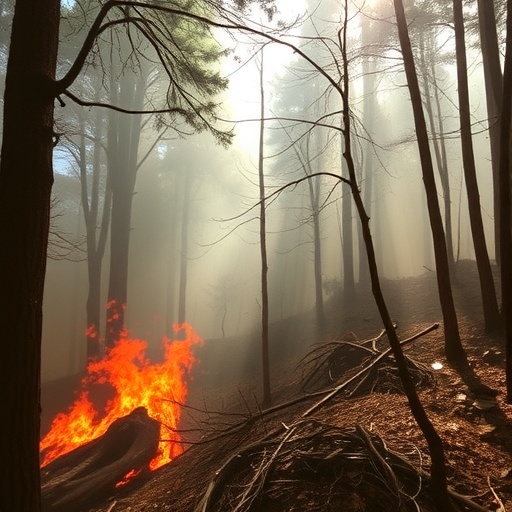In the landscape of environmental research, one of the most pressing concerns is the vulnerability of forest ecosystems to fires. A recent study spearheaded by a group of researchers led by Malik et al., published in “Discoveries in Forestry,” has delved deep into assessing forest fire vulnerability using a unique approach—fuzzy Analytic Hierarchy Process (fuzzy-AHP). This innovative methodology seeks to provide insights from the Poonch forest division in Jammu and Kashmir, a region where the interplay of ecological factors and human activity poses a significant risk for fire outbreaks.
With climate change intensifying weather patterns, the frequency and severity of forest fires have seen a notable increase worldwide. Understanding the vulnerabilities inherent in various forest ecosystems is crucial for developing comprehensive fire management strategies. The researchers employed fuzzy-AHP to quantify and prioritize factors that contribute to fire susceptibility. This method augments traditional assessment techniques, enabling the integration of qualitative judgments with quantitative data, a necessity when dealing with complex environmental variables.
Jammu and Kashmir, characterized by its diverse flora and unique forest compositions, provides an ideal setting for this pivotal research. The region’s forests are not only vital for biodiversity but are also crucial in sustaining local communities that rely on these resources for their livelihoods. As fire risks rise, the implications extend beyond ecological damage to social and economic consequences, making this research incredibly timely and relevant.
The study meticulously identified and examined various contributing factors to forest fire vulnerability, ranging from climatic conditions and topographical features to human activities and existing forest management practices. By employing fuzzy-AHP, the researchers could effectively capture the nuances of each factor’s impact, creating a more comprehensive vulnerability assessment. This systematic approach is essential as it allows for prioritization in wildfire management and prevention strategies.
Moreover, this research reinforces the critical need for integrating scientific findings into policymaking. The predictive models developed through the study could serve as a guide for local governments and environmental bodies to allocate resources effectively and implement preemptive measures. By understanding which areas are most vulnerable, stakeholders can engage in targeted mitigation efforts, thus minimizing potential damage caused by wildfires.
A striking feature of the study is its grounding in local context. The researchers conducted field surveys and collaborated with local communities and experts to validate their findings. This participatory approach is vital as it fosters a sense of ownership and responsibility within local populations, encouraging them to engage in forest management practices that enhance fire resilience.
As the study sheds light on the multifaceted dimensions of forest fire vulnerability, the implications are far-reaching. For instance, understanding the interaction of various risk factors provides the groundwork for developing enhanced fire prediction models. Additionally, these insights pave the way for more effective implementation of reforestation efforts and forest conservation strategies, thereby contributing to a more sustainable ecological future.
The research further highlights the urgent need for continuous monitoring and data collection in forested areas. As climatic conditions evolve, so too will the patterns of fire vulnerability. Establishing an ongoing assessment framework can ensure timely updates to management practices and policies, thereby fostering a proactive approach to fire risk management.
Finally, the study serves as a framework that could be replicated in other regions facing similar ecological challenges. As global temperatures rise and the human footprint on natural ecosystems expands, the methodologies applied by Malik and his team offer a roadmap for future research efforts worldwide. This study stands as a testament to the power of integrating advanced methodologies like fuzzy-AHP in environmental science, paving the way for enhanced forest conservation and management practices.
In conclusion, as we face unprecedented environmental challenges, research like that conducted by Malik et al. underscores the importance of innovation, collaboration, and proactive measures in protecting our forests. Through strategic assessments of vulnerability to forest fires, we can equip ourselves with the necessary tools to ensure the sustainability of these vital ecosystems for generations to come.
Subject of Research: Forest fire vulnerability assessment using fuzzy-AHP
Article Title: Assessing forest fire vulnerability with fuzzy-AHP: insights from Poonch forest division, Jammu and Kashmir
Article References:
Malik, F.A., Mushtaq, F., Farooq, M. et al. Assessing forest fire vulnerability with fuzzy-AHP: insights from Poonch forest division, Jammu and Kashmir.
Discov. For. 1, 4 (2025). https://doi.org/10.1007/s44415-025-00004-5
Image Credits: AI Generated
DOI: 10.1007/s44415-025-00004-5
Keywords: Forest fire vulnerability, fuzzy-AHP, ecological research, wildfire management, Poonch forest division, Jammu and Kashmir, climate change, environmental policy.




